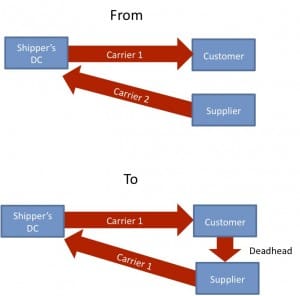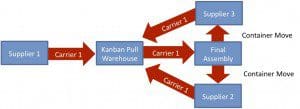I’m working on developing a supplier selection tool for Transportation Management Systems (TMS), and one form of optimization a TMS can support is “continuous moves.” I wanted to learn more about continuous moves and so I called several of our Logistics Viewpoints sponsors to discuss this topic.
First of all, what is a continuous move?

Continuous moves involve a shipper stringing loads together for their carrier, so that the carrier can better utilize a particular truck or asset. In return, the shipper shares in the improved asset utilization by receiving a discount. Both sides profit by connecting the moves with minimal deadhead or empty miles between drop-off and pick-ups. In an example, perhaps a carrier offers $1.50/mile for a single leg but if the shipper provides continuous moves they may agree to a $1.35 rate for all miles including the empty miles between the first drop and the second pickup. Mark Nix, the CEO of Cloud Logistics, mentioned that several years ago some carriers offered even deeper discounts when shippers would connect several legs over several days, but most common carrier contracts today are of the first scenario, probably because it is less difficult to calculate for both parties. A variety of other pricing schemes are also used.
Fab Brasca, VP of Global Logistics at JDA Software, pointed out that not all TMS solutions have rate management engines that are flexible enough to handle the pricing variability, or have “trip” logic (multiple loads executed using one power unit) that makes executing and auditing the moves so much easier.
Certain industries are much better suited to continuous moves. Dave Belter, VP of Transportation Management at Ryder, pointed to final assembly in the automotive industry as providing very good forward visibility and predictability around loads. In this case, the plant knows it will produce so many cars; that knowledge propagates backwards to the Tier 1 suppliers that send components to the Kanban warehouse that feeds final assembly. Routes are engineered to maximize the efficient flow of components into the assembly plant and returnable containers back to the supply base. Further, the automakers have often asked key suppliers to build their plants close to their assembly plant.

The predictability and network control is what makes continuous moves work in the final assembly automotive supply chain.
Steve Barber, VP of Strategic Carrier Development at Transplace, pointed out that a supply chain with predictable reverse logistics movements also has great potential for continuous moves. For example, car battery manufacturers deliver batteries to dealerships, pick up the dead batteries, and take those batteries to a lead smelter that melts them down to recover the lead, and then heads home.
Several of the executives I interviewed pointed out that a continuous move is mathematically very similar to planning backhauls for dedicated and private fleets. Interleaving arrivals, departures and backhauls for a private fleet has better economics, is easier to execute, and is far more the norm than is the case with continuous moves.
Sean Burke, the VP of Customer Logistics at Ryder, pointed out the value of engineering studies — loading historical and forecast move data into a transportation network planning tool — in uncovering continuous moves and other forms of interleaved movements. An engineering study uncovers potential round trip opportunities based on how lanes complement each other. If the lanes are cleverly constructed, more opportunities will present themselves. And, not surprisingly, the larger a shipper’s network the more opportunities will be uncovered. While these studies may uncover ad hoc continuous moves that may not be worth pursuing, these tools can also uncover more predictable continuous moves described in this article, as well as a variety of opportunities for a private or dedicated fleet. In Ryder’s case, as well as other TMS or 3PL suppliers that have visibility to a network of customers and their moves, there are more opportunities to uncover collaborative cross-customer move opportunities. And in Ryder’s case, it also has visibility to its own fleet of trucks. Cross-company collaborative moves can fall apart in dozens of ways. Collaborative continuous moves are easier to execute if they involve the Lead Logistics Service Provider’s own trucks.
Kevin McCarthy, Director of Consulting at C.H. Robinson, is aware of a large shipper that had given key carriers the ability to look at upcoming moves and suggest continuous moves that fit their network. However, this shipper has eliminated this program. McCarthy thinks this is because the shipper’s other carriers reacted to the new, less favorable mix of freight by raising rates and nullifying the savings from continuous moves.
Next week, in Part 2, I’ll write about the special difficulties involved in using a TMS to capture a more ad hoc, opportunistic form of continuous moves.

















